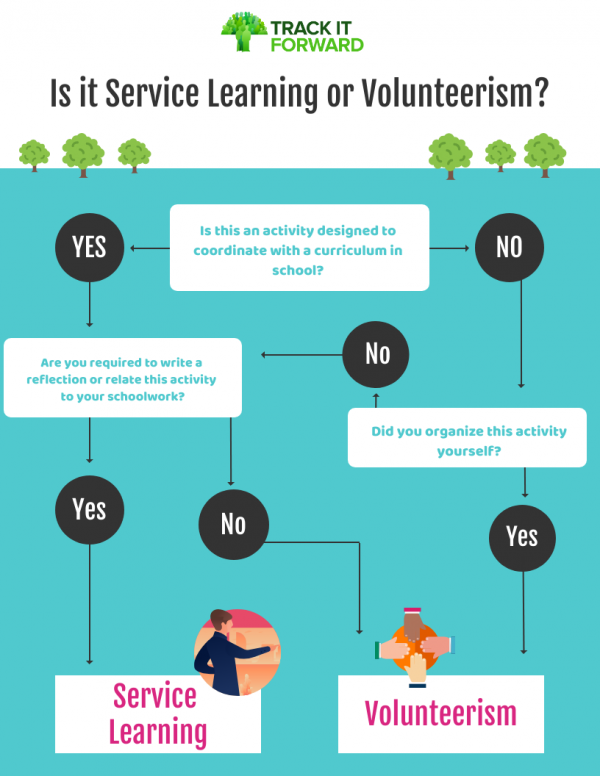Oftentimes, volunteers who are hoping to help out their community and gain noticeable volunteer hours accumulated for either their resume, a scholastic requirement, or just in general use the terms “service learning hours” and “volunteer hours” interchangeably. Sometimes, they mix the two to create “volunteer service!” But, there is a difference between volunteering and service learning, one that should be noted when looking for volunteers so everyone is on the same page.
Key Differences between service learning and volunteering:
- Service learning is always tied to a curriculum in a school. It should usually be related to course material, or serve the purpose of learning about a specific topic. Service learning will usually require a reflection or some sort of written work showcasing how the individual learned within the activity.
- Volunteering is always on behalf of an organization in operation to help service said organization or the community. The time is always unpaid and voluntary, meaning the individual decides to volunteer in their own free time.
- Service learning is usually organized on behalf of the institution that is responsible for the curriculum, where volunteering is organized by the volunteer within an organization.
It is important to note that volunteering and community service also get confused, community service is technically the word used to describe volunteering that is mandatory or required by a court, judge, etc. But, in some cases, they can be used interchangeably considering that volunteering is helping to serve the community.
Beyond the key differences between service learning and volunteering, there are some important details in the fundamentals of each activity that also help explain the difference.
The Purposes of Service Learning Vs Volunteering:
Service Learning: to help an individual understand a topic they are learning about in class with hands-on experience.
Volunteering: to serve a community or organization in efforts to get better results in their mission.
The Act of Service Learning Vs Volunteering:
Service Learning: usually a one-time act, whether it be a few hours or a month-long program continuously. In addition, the time spent within service learning activities is usually spent drawing connections to the curriculum or reflecting.
Volunteering: can be one-time or it can be a commitment to an organization, where you go back multiple times. You may do different activities each time, or the same, and you can spend one hour to a full day, depending on the organization.
The Requirements of Service Learning Vs Volunteering:
Service Learning: the school or institution in which you are receiving a curriculum can require you to do a certain amount of service learning hours in order to progress. There will also be school work related to the experience which will be a requirement in order for these hours to be counted.
Volunteering: the nonprofit organization can ask of a minimum requirement for repeat volunteers, but other than that volunteering is completely, well voluntary. Most of the time, the only requirement is that you have a positive attitude! Fine print: an organization, like a school, can require an individual to obtain a certain amount of volunteer hours, this just means that the activity does not have to be related to curriculum and will be organized on behalf of the individual, not the school.
The End-Game of Service Learning Vs Volunteering:
Service Learning: other than learning valuable life skills, service learning offers a skill to put on a resume. If you are an adult and attend a long-term service learning program, this builds raw skills that are excellent to showcase on a resume!
Volunteering: other than creating community service connections and helping others, volunteering provides an insight into your personality when placed on a resume. Employers value someone who is passionate about helping their community, volunteerism helps showcase this!
Another essential way to tell the difference between service learning and volunteering is by the activity itself. Most volunteering, with some exceptions, is done on behalf of a nonprofit organization, helping them and their goals specifically. While service learning can be more of a learning process, it can sometimes be an activity that does not directly serve the community or a nonprofit organization.
Examples of service learning activities:
- Field trips to a museum, farm, etc.
- Voluntary tutoring to younger children
- Planting trees for an institution
- Study Abroad or Mission Trips
- Find more examples of COVID-friendly service learning activities here!
Examples of volunteering:
- Helping clean and walk dogs at an animal shelter
- Serving food at a soup kitchen
- Cleaning parks up
- Helping to staff a large fundraising event
- Making and bringing stuffed animals to children’s hospitals

Service learning is a great opportunity for students to get experience in the real world of a topic they are learning about in the classroom. Service learning helps many teachers and institutions show students how what they are teaching is relevant, and expose them to the issues of the world and how they can try to make a difference.
This is not to say volunteering is not enriching in teaching as well. Many volunteer activities allow individuals to learn more about their community and themselves by participating in activities to make their community better. Workplaces are starting to give Volunteer Time Off, like Paid Time Off but with volunteering to help boost positivity and community morale within the organization! This is a great way to motivate volunteering and see what your employees are interested in within the community.
Service learning and volunteerism are very similar in the sense that they are both unpaid opportunities for individuals to help others while simultaneously learning more about themselves and the world around them. Many volunteer opportunities can easily be considered service learning, and many service learning opportunities are usually individuals volunteering time! While the difference between service learning and volunteering is minimal, it is still important to see how both of these activities are beneficial in their different ways.
How Track It Forward Helps Both Service Learning and Volunteer Programs
Track It Forward provides volunteer tracking software to both institutions and nonprofit organizations. Schools collecting and monitoring service learning hours, nonprofit organizations tracking their volunteer’s hours, or employers looking to support employee volunteerism can use Track It Forward. Here’s how:
Time Tracking:
All volunteers can log their own hours, or the organization can put them in on their own. The hours can even be categorized. For example, if you are a school that tracks both service learning hours (organized by the school) and volunteer hours (organized by the individual), they can log their hours in these specific areas and this feature will automatically organize the hours.
Approve Hours:
Specifically for service learning hours, this tool works. As an admin, you can have access to approve hours that are submitted. This means you can see when someone tries to log hours for their requirement and you can approve them or reject them if they do not fit the description or needs. You can approve hours in bulk, or directly message the volunteer from the software dashboard to tell them why it was not approved.
Reports:
Volunteer organizations and institutions requiring service learning hours can use the reporting tool to showcase their volunteers, the different activities they are doing, the average amount of hours being submitted, and more. Track It Forward creates reports instantaneously based on different grouping and categories. As an admin, you can pick what you would like to showcase in a report and it generates for you in a downloadable document.
Milestone system:
If an organization requires a certain amount of hours to get a prize or for a general requirement, both individuals and organizations can see a milestone report, which shows how close each individual or organization as a whole is to the requirement.
Embeddable tools:
Track It Forward also provides embeddable tools like event calendars, logging systems, and milestone achievement charts to be placed directly on an organization’s website. This makes it extremely easy for institutions and organizations.
Track It Forward is a great resource that all institutions, organizations, and volunteers can depend on. Whether you are tracking or providing service learning hours or volunteer hours, Track It Forward can help. Check out some of our Success Stories with different organizations!
Frequently Asked Questions:
1. Can I earn money if I do service learning?
No, service learning should be an unpaid activity, like volunteering.
2. How is service learning different than an internship?
Service learning is in coordination with a curriculum in school and focuses on education. An internship is more focussed on a career, is an external activity from school and is focused on experiences within a job or career environment, it does not have to be within a school curriculum or activities related to a school curriculum.
3. Why do people truly volunteer?
Some people volunteer for a social aspect, some because it simply makes them feel good. Some people feel it is their purpose or civic duty to be engaging in the community. The reasons are different for everyone!
 Last updated by
Last updated by